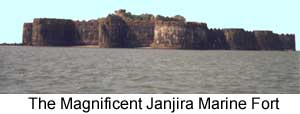

 |  |
|

Think of India and one thinks of the vast, seething interior, peoples of the plains, peoples of the hill country, great events, great cities, amid a mighty landscape. And yet the coastal forts of Maharashtra, land of the daring Maratha clans, played a significant role in the later history of India. Like forts everywhere, they were entrecotes for ideas and cultures but in additions there harbours were the natural object for the vessel for all the eastward-trading nations- the Sidhis and the Abyssinians were collectively called by that name. They came as slave traders to the Deccan and dealt with the Adil Shahis of Bijapur. In return for these concessions they provided armed escort to the pilgrim ships bound for Mecca out of Janjira, Goa, Surat and Dhabod: corsairs- Dutch or English or from Malabar- were a constant danger to merchant shipping, looting, killing and raping on the high seas from the African coast to the East Indies. The Maratha chieftain, Shivaji, first attacked Janjira during his campaigns in the Konkan area in 1659. His son Shambhuji in 1682 attempted to tunnel to the island but with signal lack of success. Each time the Marathas assaulted the fort the Sidhi and the Mughal fleet from Surat combined to bombard them from the region. Though they tried hard, neither the Marathas, nor the Mughals, nor Portugese, nor British could ever capture Janjira by force. Janjira lies some way offshore but it is possible to hire a square-rigged dhow to visit it. The dhows ply from the port of Murud, a tiny place that was hardly moved on from the 16th century. The island is uninhabited now. Jazire Meharuba, the Moon Fort, beckons, the more beguiling since one may be sure of approaching it in a manner unchanged down the centuries. Luxuriant in a palace garden grown wild, Janjira must have been an idyllic place. Some of the great, rusting guns of Janjira still point from their embrasures: Chavari, its muzzle carved like the jaws of some fearsome monster; Kalal Bangadi; and Landa Kasam. This was the Sidhi Surul Khan's palace; one can still patrol and admire his ramparts of blue-black granite, jointed with lead to withstand the pounding of the Arabian Sea. At the steps by the main entrance is a memorial to six battle victories - the lion of Abyssinia holding six elephants captive. It is almost impossible, though, for today's visitor to harbour thoughts of bloody bombardment into dust or a burning death at sea. This is a quiet, seductive spot to leave, with day darkening into night and blue waters turning gold in the sinking sun, the soft slap of wave on wood the only sound. |
Copyright ©2000 indiansaga.com. All rights reserved.
By using this service, you accept that you won't copy or use the data given in this website for any commercial purpose.
The material on IndianSaga.com is for informational & educational purpose only.
This site is best viewed at 800 X 600 picture resolution.